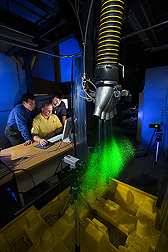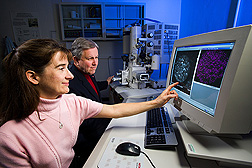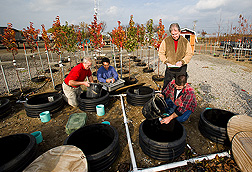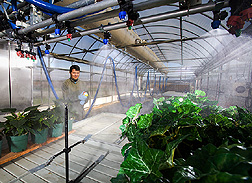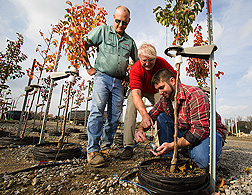Fine-Tuning Nursery and Greenhouse Plant Care
Since some scientists are saying that water may become as scarce as oil over the coming decades, nursery managers are among the growers most interested in ways to get by on less water.
Over the past 3 years, ARS research leader and plant pathologist Charles Krause, at the ARS Application Technology Research Unit (ATRU) in Wooster, Ohio, has assembled a team to study water, nutrient, and pesticide management for horticultural plants.
The team has developed an improved strategy for year-round monitoring of the plants’ water and nutritional needs. The team includes ARS agricultural engineers Heping Zhu and Richard Derksen, ARS entomologist Mike Reding, and Ohio State University extension horticulturist Randy H. Zondag, in Painesville, Ohio. In Toledo, Ohio, ARS plant pathologist James Locke and horticulturist Jonathan Frantz are doing similar studies related to floriculture production. Locke and Frantz are at ATRU’s Greenhouse Production Research Group worksite at the University of Toledo and the Toledo Botanical Gardens.
As part of a cooperative research and development agreement, Willoway Nurseries, in Avon, Ohio, provides ARS with land and labor while ARS provides the monitoring equipment and researchers.
Strive to Thrive
Currently a $50-billion-a-year industry nationally, horticulture is one agricultural industry that thrives with urban and suburban development. But the same development that boosts demand for ornamental plants also brings impervious roofs, roads, and driveways that rush storm water to streams. The water is more likely to be contaminated with road salt or other pollutants.
|
|
The last thing horticulture wants to do is add to the problem with excess nutrients or pesticides draining away in wasted water.
The new monitoring/application system isn’t commercialized yet, but the operator of the nursery where it’s being tested and others who’ve heard about the results have already reduced water use by as much as 40 percent or more. “This is beginning to change the way some growers do business,” says Krause. “And that’s what our research is all about—helping growers do a better job.”
The experimental system currently uses 30 sensors for each plot of 50 trees, and an ARS field weather station on the nursery grounds is linked to computer data loggers. The system takes readings every minute, 24 hours a day during the growing season. Thermocouples measure temperature of the soil or other media the plant is growing in, while other sensors measure moisture.
Excess water drains away from potted plants through a pipe into a buried sump. Inside the sump are small versions of “tipping bucket” rain gauges long used on farm fields to monitor water runoff. The team designed the buckets as a way to measure the flow rate of water draining from plants as part of the entire experimental monitoring system.
The scientists take samples from the sump weekly to monitor water quality and check levels of wasted nutrients and pesticides. Researchers have found that applying water at a slower rate several times a day reduces the total amount of water needed for proper plant growth and, at the same time, reduces waste.
“This system has reduced energy costs and could show growers how to reduce fertilizer applications,” Krause says. “It could also prove to be the best method to deliver many pesticides, with reduced exposure to applicators and other workers. The improved growing environment will help keep plants growing with fewer problems. Growers will have a better understanding of what is going on in the nursery and be able to make better use of inputs when needed.”
Zondag says, “In my 30 years in the horticultural industry, I’ve never been involved in a project where the results came in so fast and were picked up by industry so fast. It usually takes 10 to 20 years, but here it happened in a couple of years. This is an unusual system in many ways, including its use of fairly simple equipment to do things I thought were impossible, like measuring the flow rate of water draining from a plant pot. This system not only makes money for growers, but also improves the environment. The study is breaking new ground for the horticultural industry.”
Better Data Means Bigger Trees
The researchers are testing the water-monitoring system on popular Red Sunset maple trees, redbuds, and Chanticleer pear trees being grown using a technique called “pot-in-pot,” which was designed to produce better plants with lower labor costs. Potted plants are set inside holder pots left permanently buried in the field. Irrigation is provided through individual spray stakes instead of trickle or overhead sprayers. When it’s time to sell the plant, the grower simply lifts the pot out of its holder pot.
|
|
Tom Demaline, president of Willoway Nurseries, where the water-monitoring test is being conducted, has been using pot-in-pot production since the mid-1990s.
“With plants in containers, we always struggle to get just the right amount of water,” Demaline says. “If we put too much, then the roots can die and we get wasteful runoff. If we put too little, the plant stops growing and there’s a potentially deadly salt buildup.
“The amount of water we would ideally apply varies with temperature and humidity. The field weather station factors in this information for us.
“This new monitoring system teaches us how to grow a better tree and simplifies our work, making it easier for us to give the exact amount of water the tree needs at each growth stage. It’s shown that the trees need water most in August. Eventually we want to learn exactly how much added nutrients the trees need and when—and to reduce loss of excess water and nutrients into the environment. We hope to get this monitoring system in commercial use in a few years.”
Krause says that in addition to the weather station set up at Willoway, “Our unit has three others—with more planned for our greenhouse production research group in Toledo.”
“Data from these weather stations is online, providing growers an archive of weather data from year to year,” adds Krause. “This enables them to decide when it’s warm enough to remove sunlight covers from field plants and when to expect insect pests to emerge. Weather data also allows them to assess many other things, such as how wet the crop leaves are. Wet leaves are breeding grounds for plant diseases such as apple scab.”
Zondag adds that by relating weather information to other data collected by the sensors, growers can anticipate plants’ “thirst” and apply precise amounts of water so the plants never wilt. And, he says, “This monitoring system can identify certain tree species that can’t survive winter in a container, even pot-in-pot.”
“We want to do for trees, shrubs, and other flowers what the industry already does for mums and poinsettias,” says Demaline. “With those plants, sensors tell growers day-by-day how much water and how much calcium and other nutrients the flowers need. If we can get that kind of precise information for nursery trees, for example, we can grow healthier trees that will bring higher prices. The bigger our tree trunk diameters, the more we get paid.”
The researchers found that the trees were receiving far more water and fertilizer than they could ever possibly use. “About 40 percent of the irrigation and rainwater drained away and was wasted,” Krause says.
|
|
More Changes Are Coming
The horticultural industry is changing rapidly, pointing to a future of automated and robotic systems with an array of sensors to monitor and control growing plants in ways that protect workers, profits, and the environment. The Wooster unit is an important key to that future.
“This monitoring system puts ARS ahead of the curve by 15 to 20 years,” Zondag says, “because of the great research team at Wooster.”
“We are part of a larger team that includes other researchers and various aspects of the industry,” Krause says. “We assembled this team because we want to develop a monitoring and application system that will consider all aspects of growing plants. Automation and careful monitoring and targeting of pesticides are essential to keeping the U.S. horticultural industry competitive globally. It takes a computerized system that monitors day and night to deal with the complex interactions between water quality and water-use efficiency, nursery crop growth, production practices, and pesticides and fertilizers to produce the healthiest plants possible while protecting the environment and conserving water.”
It’s a tall order, but the Wooster researchers’ work has gone a long way toward fulfilling it. Their first monitoring experiment began in 2003 with 50 potted plants. Thanks to industry interest, they’ve expanded the study to 3 plots with 150 trees in pot-in-pot containers, and another plot with 50 aboveground container trees. Krause and colleagues are applying for grants to expand the research even further.—By Don Comis, Agricultural Research Service Information Staff.
This research is part of Crop Protection and Quarantine, an ARS National Program (#304) described on the World Wide Web at www.nps.ars.usda.gov.
Charles R. Krause is in the USDA-ARS Application Technology Research Unit, 1680 Madison Ave., Wooster, OH 44691; phone (330) 263-3676, fax (330) 263-3670.
"Fine-Tuning Nursery and Greenhouse Plant Care" was published in the February 2006 issue of Agricultural Research magazine.







